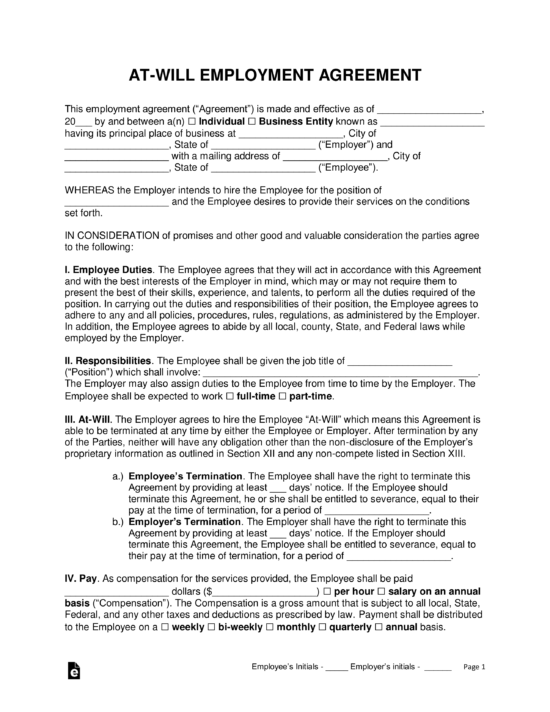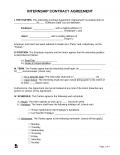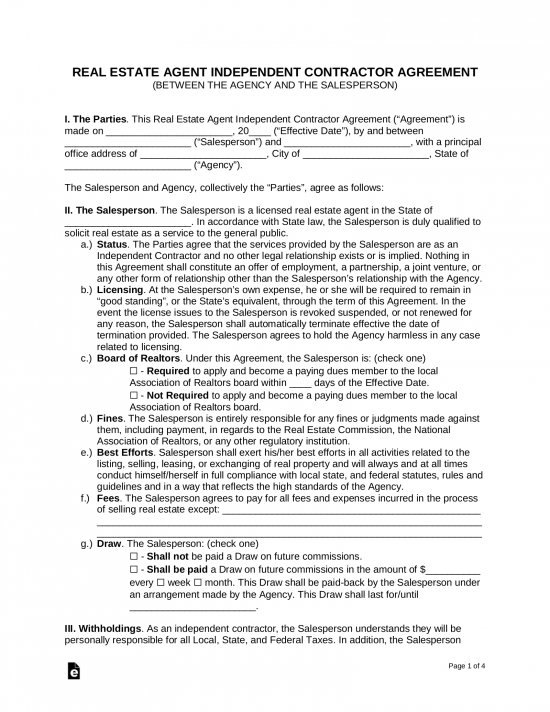By State
- Alabama
- Alaska
- Arizona
- Arkansas
- California
- Colorado
- Connecticut
- Delaware
- Florida
- Georgia
- Hawaii
- Idaho
- Illinois
- Indiana
- Iowa
- Kansas
- Kentucky
- Louisiana
- Maine
- Maryland
- Massachusetts
- Michigan
- Minnesota
- Mississippi
- Missouri
- Montana
- Nebraska
- Nevada
- New Hampshire
- New Jersey
- New Mexico
- New York
- North Carolina
- North Dakota
- Ohio
- Oklahoma
- Oregon
- Pennsylvania
- Rhode Island
- South Carolina
- South Dakota
- Tennessee
- Texas
- Utah
- Vermont
- Virginia
- Washington
- Washington D.C.
- West Virginia
- Wisconsin
- Wyoming
By Type (6)
- At-Will Employment Agreement
- Independent Contractor Agreement
- Internship Agreement
- Non-Compete Agreement
- Non-Disclosure Agreement (NDA)
- Subcontractor Agreement
 At-Will Employment Agreement – No time-period commitment by the employer. May terminate at any time with or without severance.
At-Will Employment Agreement – No time-period commitment by the employer. May terminate at any time with or without severance.
Download: PDF, MS Word, OpenDocument
 Independent Contractor Agreement – Classified by the IRS as a 1099 Employee, is an individual or entity that is paid to perform a service. Examples include contractors, medical professionals, attorneys, etc.
Independent Contractor Agreement – Classified by the IRS as a 1099 Employee, is an individual or entity that is paid to perform a service. Examples include contractors, medical professionals, attorneys, etc.
Download: PDF, MS Word, OpenDocument
 Internship Agreement – When hiring an unpaid intern that agrees to work for on-the-job training related to their field of study.
Internship Agreement – When hiring an unpaid intern that agrees to work for on-the-job training related to their field of study.
Download: PDF, MS Word, OpenDocument
 Non-Compete Agreement – Depending on the restrictions, it does not allow an employee to work for a competitor or in the same industry as the employer.
Non-Compete Agreement – Depending on the restrictions, it does not allow an employee to work for a competitor or in the same industry as the employer.
Download: PDF, MS Word, OpenDocument
 Non-Disclosure Agreement (NDA) – Requires an individual or business to keep information that was learned from the employer confidential.
Non-Disclosure Agreement (NDA) – Requires an individual or business to keep information that was learned from the employer confidential.
Download: PDF, MS Word, OpenDocument
 Subcontractor Agreement – Made between a contractor and a subcontractor. When a contractor has made an agreement with an individual or company they will then use a subcontractor agreement to satisfy portions of the original agreement by hiring other known specialists.
Subcontractor Agreement – Made between a contractor and a subcontractor. When a contractor has made an agreement with an individual or company they will then use a subcontractor agreement to satisfy portions of the original agreement by hiring other known specialists.
Download: PDF, MS Word, OpenDocument
What is an Employment Contract?
An employee contract is between an employer willing to pay an individual for their services. The employer can choose to pay the employee per hour or on a salary (annual basis). The employee is required to uphold their duties and responsibilities for the duration of the contract.
IRS Requirements
The following documents are required for US companies hiring citizens and residents:
- IRS Form W-4 – Required to be completed by the employee at the start of employment.
- IRS Form W-9 – Required to be completed by an independent contractor at the start of employment (if more than $600 is to be paid for services or labor).
Provisions and Clauses of an Employment Contract
An employment contract is made up of different stipulations. Upon signing the agreement — as long as the provisions and clauses are within the bounds of the law — the contract is effective. It’s important for both employers and employees to know what rules to which they’re bound during someone’s employment term.
Duties: The employee’s title and main duties bind the worker to carry out the duties within the contract. Adding clauses that suggest that the duties could change over time always pads a contract with flexibility.
Compensation: Compensation sets the starting wage that the employee will be paid and is typically categorized into salary (yearly pay) or hourly pay, as well as how often the employee will be paid.
Termination: Some employment contracts are not longstanding, and some have an end date. Some renew yearly. The termination date of the contract would be listed in these cases, but in the case of at-will employment, the termination section might be where
Non-Compete: Employers have the option to include a non-compete clause for a set timeline, which would prevent workers from bringing trade secrets to competing organizations. With a stringent non-compete, employees that leave might not be able to work for employees in similar industries.
Trial Period: Also known as the “probationary period,” and is when a new employee is hired on a no-commitment basis for a set time, after which the employer will have the choice of either terminating or retaining the employee. If the employee is retained, employer benefits like healthcare and more typically begin.
Benefits: Benefits like health insurance, PTO, sick leave, and any other extras that the company provides the employee in addition to their salary should be listed.
Frequently Asked Questions (FAQs)
- Difference between Part-Time vs. Full-Time
- Difference between Employee vs. Independent Contractor
- What is At-Will Employment?
- What are the Federal Employment Discrimination Laws?
Difference between Part-Time vs. Full-Time
- Part-time: Generally speaking, an employee working between 1 to 34 hours per week can be qualified as full-time employment in the United States.
- Full-time: There are no federal laws that define “full-time work”, although 35 to 40 hours per week is considered to be full-time work. 40 hours is the maximum number of hours that an employee can work in a given workweek before overtime is required (overtime pay must be at least one and a half (1.5) times pay).[1]
Difference between an Employee vs. Independent Contractor
The main difference is that an employee has federal and state withholding taken from their pay by the employer while an independent contractor is responsible for payment of their own taxes to federal and state authorities.
Employee
- Employer does withhold tax payments;
- When hiring, employee completes IRS Form W-4;
- Employer does obtain unemployment insurance;
- Paid hourly or salary; and
- Employee works for the employer’s business.
Independent Contractor
- Client does not withhold tax payments;
- Contractor completes IRS Form W-9;
- Client does not obtain unemployment insurance;
- Paid per project or task; and
- Contractor works for their own business.
What is At-Will Employment?
Almost every employee who is part of an organization’s staff is employed “at will,” except those in the state of Montana. At-will employment is a type of employment where either the employee or the employer may terminate employment at any time, but the employer may not do so for any illegal reason.
What are the Federal Employment Discrimination Laws?
Workplaces are subject to federal employment and hiring discrimination laws. Employees and applicants may not be discriminated against on the basis of:[2]
- Race
- Color
- National origin
- Religion
- Sex (including gender identity and sexual orientation)
- Pregnancy
- Age (40 or older)
- Disability
- Genetic information
Sample
Download: PDF, MS Word or OpenDocument Text
How to Hire an Employee (7 steps)
Before writing an employment agreement hiring parties should meet to discuss main employment terms such as hourly pay/salary, job title, and responsibilities. The agreement will typically be written under the company policy which governs vacation time, personal leave, and benefits.
1. Make a Job Posting
 The employer will need to utilize the internet to find the best talent. Far gone are the days of advertising in the “help wanted” section of the newspaper. Today, employers depend on referrals, recruiting agencies, and applications received via online job postings.
The employer will need to utilize the internet to find the best talent. Far gone are the days of advertising in the “help wanted” section of the newspaper. Today, employers depend on referrals, recruiting agencies, and applications received via online job postings.
Executive Positions
Entry-Level Positions
Seeking Out Talent
If the employer is looking to acquire talent from another company it is best to use social networks and contact them privately. However, if an employer is looking for top-level or specialized talent, a recruiting agency, though expensive, might be a better solution than spending countless hours searching for candidates.
Top Recruiting Agencies
2. Reviewing Applications
 The employer will likely receive a high number of applications and letters from potential candidates interested in the position. They will have to filter the candidates that they believe will be the best fit for the organization by their qualifications. It is against the law for employers to discriminate against applicants.
The employer will likely receive a high number of applications and letters from potential candidates interested in the position. They will have to filter the candidates that they believe will be the best fit for the organization by their qualifications. It is against the law for employers to discriminate against applicants.
3. Set Up Interviews
 Before any commitments are made, it’s best to have a conversation with multiple candidates to evaluate their strengths and weaknesses. It is also a good idea for the employer to have pre-written questions that explore not only the candidate’s job qualifications but also how they would react if put in particular situations in the workplace.
Before any commitments are made, it’s best to have a conversation with multiple candidates to evaluate their strengths and weaknesses. It is also a good idea for the employer to have pre-written questions that explore not only the candidate’s job qualifications but also how they would react if put in particular situations in the workplace.
Free Video Chat Apps
4. Perform a Background Check
 Before any negotiations take place the employer should perform a criminal background check on the individual. Even though a person may be qualified for a job, he or she may have past convictions that will give an employer an idea of any violent or unlawful history.
Before any negotiations take place the employer should perform a criminal background check on the individual. Even though a person may be qualified for a job, he or she may have past convictions that will give an employer an idea of any violent or unlawful history.
Background Check Providers
- GoodHire.com – $29.99 plus a one-time setup fee of $49.99
- BackgroundChecks.com – $33.15
- Accurate.com – $29.95
- Checkr.com – $54.99
| GOODHIRE | BACKGROUNDCHECKS | ACCURATE | CHECKR | |
| PRICING | $79.99 | $33.15 | $29.95 | $54.99 |
| DELIVERY | 3-5 BUSINESS DAYS | INSTANT | VARIES | 3-7 BUSINESS DAYS |
| EMPLOYMENT VERIFY | $14.99 EXTRA | X | X | X |
| SSN VERIFICATION | √ | √ | √ | √ |
| ADDRESS HISTORY | √ | √ | √ | √ |
| COUNTY CRIMINAL RECORDS | √ | X | √ | √ |
| NATIONAL CRIMINAL RECORDS | √ | √ | √ | √ |
| CREDIT CHECK | $14.99 EXTRA | X | X | X |
| SEX OFFENDER REGISTRY | √ | √ | √ | √ |
| SCHOOL RECORDS | $14.99 EXTRA | X | X | X |
| DRIVING RECORDS | $14.99 EXTRA | X | X | X |
| PROFESSIONAL LICENSE VERIFICATION | $14.99 EXTRA | X | X | X |
| U.S. TERROR WATCH LIST | √ | √ | √ | X |
Sex Offender Check
- www.nsopw.gov – Federal website.
5. Negotiate the Terms
 The employer and employee should negotiate and agree to the following:
The employer and employee should negotiate and agree to the following:
- Duties – Title and role in the company.
- Period – At-will or for a specific length of time.
- Payment – Salary or $/hour including any commissions or bonuses.
- Benefits – Such as health care, retirement plans, etc.
- Ownership Interest – If ownership will be a part of the agreement.
- Vacation Time – How many days off per year.
- Personal Leave – Days off for personal or health-related matters.
- Confidentiality (NDA) – If the employee will be required to keep the company’s proprietary information a secret.
- Non-Compete – If the employee will be prohibited from working for competitors or in the same industry.
If the employer is a larger company, many of the above-listed items will be located in the employee handbook. Otherwise, the employer and employee will be responsible for negotiating their terms respectively.
After the initial negotiations are complete, the employer will authorize a job offer letter that includes the terms of employment.
6. Write the Employment Contract
 Download: PDF, Microsoft Word, or Open Document Text (.odt).
Download: PDF, Microsoft Word, or Open Document Text (.odt).
After completing, both parties are advised to take the document to their respective legal counsel. If the employee and employer agree to the terms of the agreement, it is time to sign.
Notary Public – It is highly recommended for executive positions that the form is signed in the presence of a notary public. A form that is notarized represents that the parties displayed government-issued identification before authorization.
7. The Hiring Process
 After hiring, the employer will need to have the employee complete and sign the following documents:
After hiring, the employer will need to have the employee complete and sign the following documents:
- IRS Form W-4 – For the employer to calculate the employee’s withholding taxes.
- Direct Deposit Authorization Form – Allows the employer to pay the employee directly via bank transfer (ACH).
- Employee Handbook – Informs the employee of standard company policies.
Minimum Wage (Federal & State)
Federal
The federal minimum wage in the United States is $7.25 per hour.[3] In most states, the minimum wage is higher.
By State
Related Agreements
 Dentist Employment Agreement – Between a dental office and a practitioner (“dentist”).
Dentist Employment Agreement – Between a dental office and a practitioner (“dentist”).
Download: PDF, MS Word, OpenDocument
 Employment Separation Agreement – Otherwise known as a “settlement” or “severance” agreement, outlines the terms and conditions of an employee’s termination.
Employment Separation Agreement – Otherwise known as a “settlement” or “severance” agreement, outlines the terms and conditions of an employee’s termination.
Download: PDF, MS Word, OpenDocument
 Real Estate Agent Employment Agreement – Between a real estate agency and an agent.
Real Estate Agent Employment Agreement – Between a real estate agency and an agent.
Download: PDF, MS Word, OpenDocument
